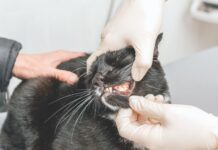Question: What is the teeth cycle of cats from kittenhood to adulthood? Do cats lose teeth as they grow older? Ive looked in one of my cats mouths and found fewer teeth than in my other cat. Is this normal? Also, is their tooth maintenance similar to ours (that is, regular cleaning, checking for cavities and periodontal disease, etc.)? How often do they require a checkup?
Answer: Kittens dont have any teeth visible at birth, but between 10 days and two weeks of age, the deciduous or baby incisors – the very tiny teeth in front – begin to erupt through the gums. The deciduous canine teeth – the four fangs at the front corners of the jaws – appear at around two to three weeks of age. Other teeth begin to poke through the gums a few days later, and by the time kittens reach two months of age all 26 deciduous teeth should have erupted.
The deciduous teeth are only temporary; they fall out and are replaced with the permanent or adult teeth beginning when kittens are around three to four months of age. The permanent teeth erupt in roughly the same order as did the deciduous teeth: The incisors come first, followed by the canine teeth (yes, I suppose they should be called feline teeth) and the cheek teeth – the premolars and molars. All 30 of the permanent teeth should be in place by the time kittens reach five to six months of age.
There To Stay
In contrast to the deciduous teeth, the permanent teeth are meant to last throughout life. Various disease processes, though, may lead to their loss: One is severe periodontal disease, and another is a progressively eroding pit called a feline odontoclastic resorptive lesion (FORL). Also called neck lesions, FORLs are cavity-like craters that most often form in a tooth near the gum line.
Approximately one-third of all cats will develop FORLs sometime during their lives. And they are extremely painful. Tooth grinding, chewing only on one side of the mouth (invariably the side opposite the tooth with the problem) and chattering of the teeth are some of the more common signs. Some cats may show no signs other than diminished appetites. But I suspect most of them suffer in silence, with owners completely unaware of the pain.
Studies have thus far failed to illuminate a definite cause of FORLs, although many theories have been proposed. Out-of-control immune responses, over-exuberant responses to viral infection, metabolic imbalances and excessive vitamin D in cat foods are just a few of the suspects. Regardless of the causes, FORLs erode deeper and deeper into the tooth over time and may actually cause it to break off, usually at or just below the gum.
Various treatment approaches have been attempted but none is able to halt progression of the disease. However, discovering FORLs as early as possible and extracting the tooth when necessary (unfortunately the only routinely successful way to deal with the problem) alleviates the considerable discomfort they cause.
Routine Checkups the Key
Regular veterinary dental examinations are of unquestionable importance, but their frequency depends a bit on the kitty. Some cats require visits every few months, while others can get by with annual visits. Not surprisingly, regular tooth brushing at home can lessen the frequency of required professional cleanings because it reduces plaque and tartar buildup, which in turn helps slow or prevent the onset of periodontal disease.
Tooth brushing might help prevent FORLs, too. In one study, cats without FORLs were more likely to have dedicated owners who cleaned their cats teeth at least twice weekly. But truthfully, not every cat will tolerate having its teeth brushed. Youll be much more successful if you start when your cat is still young.
Make sure to ask your veterinarian to show you how to brush your kittens teeth during one of the first pediatric visits. As I can personally attest, initiating a home tooth-brushing program with an adult cat usually ends in frustration and failure.



